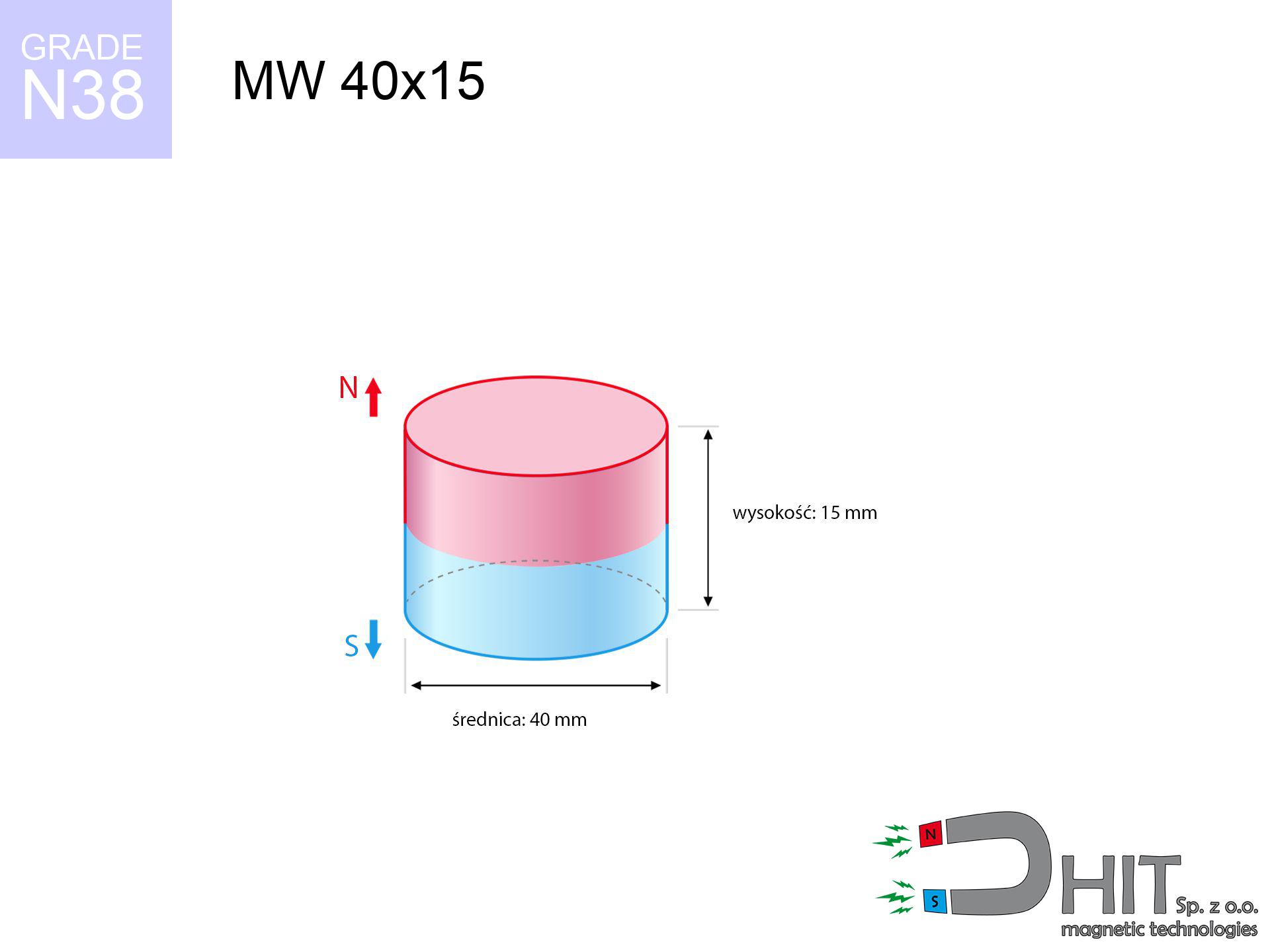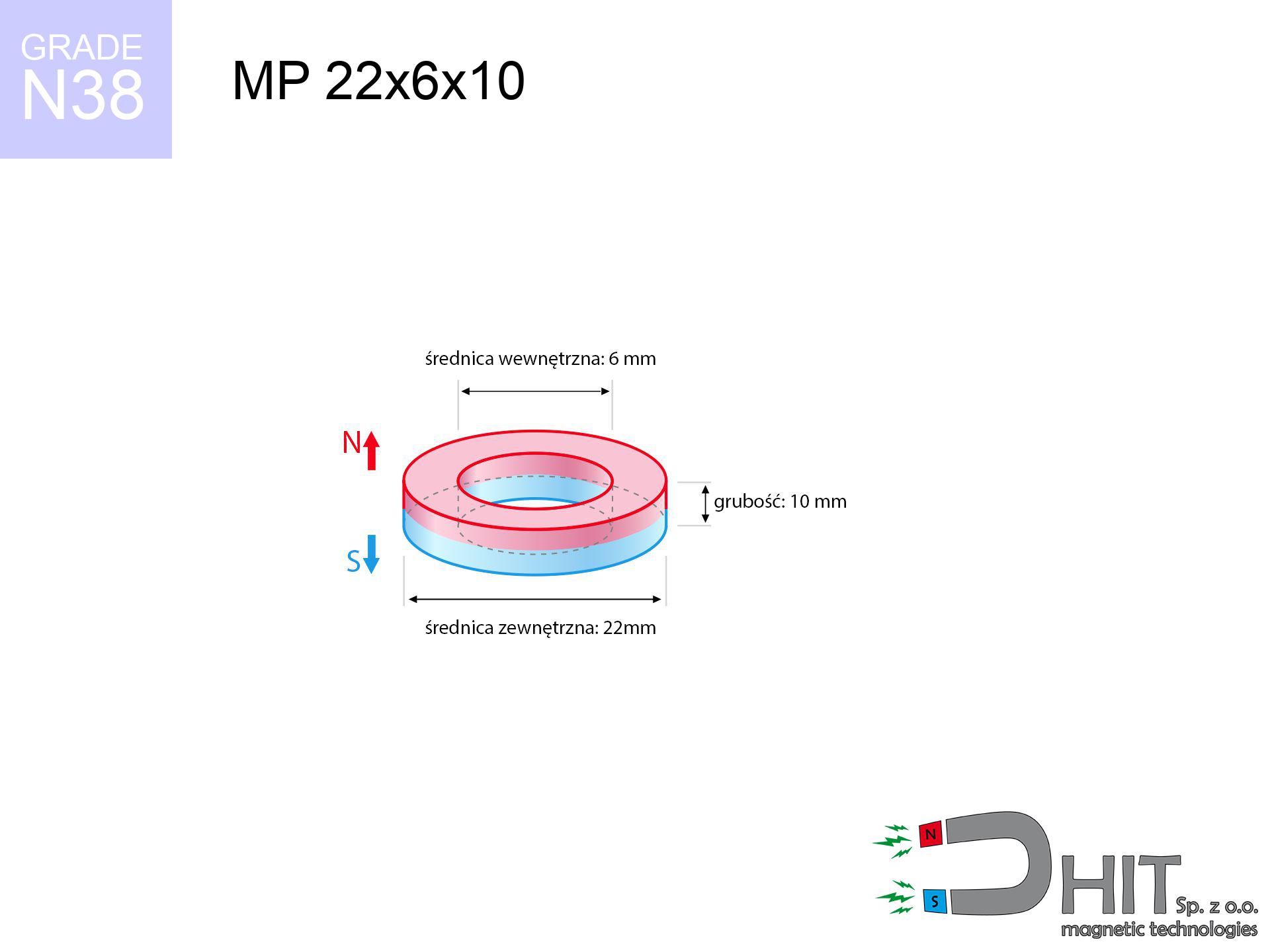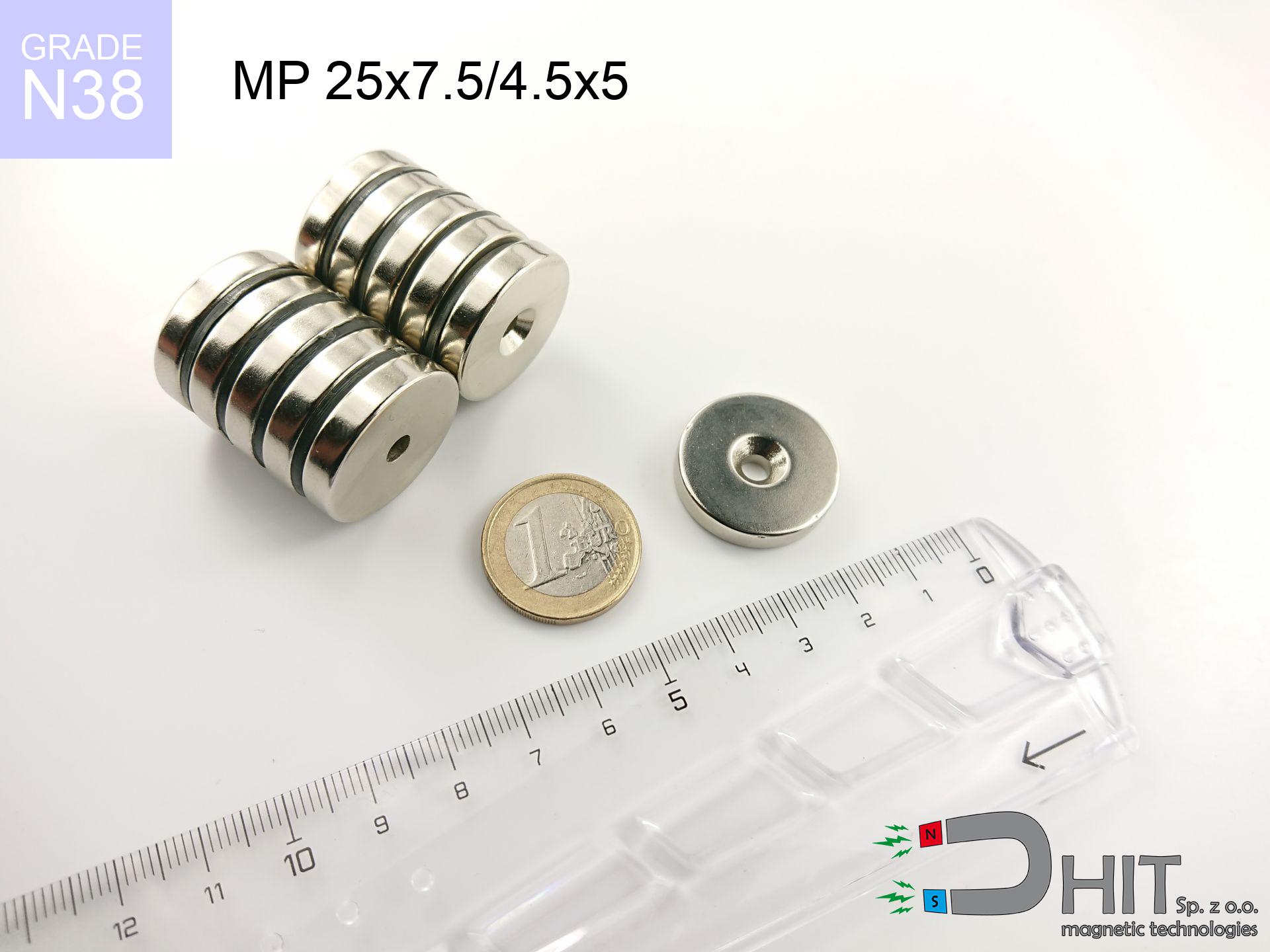MW 40x15 / N38 - cylindrical magnet
cylindrical magnet
Catalog no 010067
GTIN: 5906301810667
Diameter Ø
40 mm [±0,1 mm]
Height
15 mm [±0,1 mm]
Weight
141.37 g
Magnetization Direction
↑ axial
Load capacity
36.52 kg / 358.25 N
Magnetic Induction
371.91 mT
Coating
[NiCuNi] Nickel
65.93 ZŁ with VAT / pcs + price for transport
53.60 ZŁ net + 23% VAT / pcs
bulk discounts:
Need more?Do you have doubts?
Call us
+48 22 499 98 98
if you prefer contact us by means of
form
the contact page.
Weight and shape of magnets can be analyzed using our
force calculator.
Order by 14:00 and we’ll ship today!
MW 40x15 / N38 - cylindrical magnet
Specification / characteristics MW 40x15 / N38 - cylindrical magnet
| properties | values |
|---|---|
| Cat. no. | 010067 |
| GTIN | 5906301810667 |
| Production/Distribution | Dhit sp. z o.o. |
| Country of origin | Poland / China / Germany |
| Customs code | 85059029 |
| Diameter Ø | 40 mm [±0,1 mm] |
| Height | 15 mm [±0,1 mm] |
| Weight | 141.37 g |
| Magnetization Direction | ↑ axial |
| Load capacity ~ ? | 36.52 kg / 358.25 N |
| Magnetic Induction ~ ? | 371.91 mT |
| Coating | [NiCuNi] Nickel |
| Manufacturing Tolerance | ±0.1 mm |
Magnetic properties of material N38
| properties | values | units |
|---|---|---|
| remenance Br [Min. - Max.] ? | 12.2-12.6 | kGs |
| remenance Br [Min. - Max.] ? | 1220-1260 | T |
| coercivity bHc ? | 10.8-11.5 | kOe |
| coercivity bHc ? | 860-915 | kA/m |
| actual internal force iHc | ≥ 12 | kOe |
| actual internal force iHc | ≥ 955 | kA/m |
| energy density [Min. - Max.] ? | 36-38 | BH max MGOe |
| energy density [Min. - Max.] ? | 287-303 | BH max KJ/m |
| max. temperature ? | ≤ 80 | °C |
Physical properties of sintered neodymium magnets Nd2Fe14B at 20°C
| properties | values | units |
|---|---|---|
| Vickers hardness | ≥550 | Hv |
| Density | ≥7.4 | g/cm3 |
| Curie Temperature TC | 312 - 380 | °C |
| Curie Temperature TF | 593 - 716 | °F |
| Specific resistance | 150 | μΩ⋅Cm |
| Bending strength | 250 | Mpa |
| Compressive strength | 1000~1100 | Mpa |
| Thermal expansion parallel (∥) to orientation (M) | (3-4) x 106 | °C-1 |
| Thermal expansion perpendicular (⊥) to orientation (M) | -(1-3) x 10-6 | °C-1 |
| Young's modulus | 1.7 x 104 | kg/mm² |
Operational Parameters - Simulation
The table shows theoretical working parameters of the magnet. Real-world results may differ from the simulation.
MW 40x15 / N38
| Distance (mm) | Induction (Gauss) / mT | Pull Force (kg) | Risk Status |
|---|---|---|---|
| 0 mm |
3718 Gs
371.8 mT
|
28.76 kg / 28762.3 g
282.2 N
|
Critical |
| 1 mm |
3563 Gs
356.3 mT
|
26.41 kg / 26414.6 g
259.1 N
|
Critical |
| 2 mm |
3398 Gs
339.8 mT
|
24.03 kg / 24025.1 g
235.7 N
|
Critical |
| 5 mm |
2880 Gs
288.0 mT
|
17.26 kg / 17257.6 g
169.3 N
|
Critical |
| 10 mm |
2069 Gs
206.9 mT
|
8.90 kg / 8901.7 g
87.3 N
|
Strong |
| 15 mm |
1439 Gs
143.9 mT
|
4.31 kg / 4305.7 g
42.2 N
|
Strong |
| 20 mm |
999 Gs
99.9 mT
|
2.08 kg / 2076.2 g
20.4 N
|
Strong |
| 30 mm |
507 Gs
50.7 mT
|
0.53 kg / 534.5 g
5.2 N
|
Weak |
| 50 mm |
169 Gs
16.9 mT
|
0.06 kg / 59.6 g
0.6 N
|
Weak |
MW 40x15 / N38
| Surface Type | Friction Coeff. | Max Load (kg) |
|---|---|---|
| Raw Steel | µ = 0.3 |
8.63 kg / 8628.7 g
84.6 N
|
| Painted Steel (Standard) | µ = 0.2 |
5.75 kg / 5752.5 g
56.4 N
|
| Greasy/Slippery Steel | µ = 0.1 |
2.88 kg / 2876.2 g
28.2 N
|
| Magnet with Anti-slip Rubber | µ = 0.5 |
14.38 kg / 14381.2 g
141.1 N
|
MW 40x15 / N38
| Steel Thickness (mm) | % Efficiency | Real Pull Force (kg) |
|---|---|---|
| 0.5 mm |
|
1.44 kg / 1438.1 g
14.1 N
|
| 1 mm |
|
3.60 kg / 3595.3 g
35.3 N
|
| 2 mm |
|
7.19 kg / 7190.6 g
70.5 N
|
| 5 mm |
|
17.98 kg / 17976.5 g
176.3 N
|
| 10 mm |
|
28.76 kg / 28762.3 g
282.2 N
|
MW 40x15 / N38
| Ambient Temp. (°C) | Power Loss | Remaining Pull | Status |
|---|---|---|---|
| 20 °C | 0.0% |
28.76 kg / 28762.3 g
282.2 N
|
OK |
| 40 °C | -2.2% |
28.13 kg / 28129.6 g
276.0 N
|
OK |
| 60 °C | -4.4% |
27.50 kg / 27496.8 g
269.7 N
|
OK |
| 80 °C | -6.6% |
26.86 kg / 26864.0 g
263.5 N
|
|
| 100 °C | -28.8% |
20.48 kg / 20478.8 g
200.9 N
|
MW 40x15 / N38
| Air Gap (mm) | Attraction (kg) (N-S) | Repulsion (kg) (N-N) |
|---|---|---|
| 0 mm |
43.14 kg / 43140.0 g
423.2 N
|
N/A |
| 2 mm |
36.05 kg / 36045.0 g
353.6 N
|
33.64 kg / 33642.0 g
330.0 N
|
| 5 mm |
25.89 kg / 25890.0 g
254.0 N
|
24.16 kg / 24164.0 g
237.0 N
|
| 10 mm |
13.35 kg / 13350.0 g
131.0 N
|
12.46 kg / 12460.0 g
122.2 N
|
| 20 mm |
3.12 kg / 3120.0 g
30.6 N
|
2.91 kg / 2912.0 g
28.6 N
|
| 50 mm |
0.09 kg / 90.0 g
0.9 N
|
0.08 kg / 84.0 g
0.8 N
|
MW 40x15 / N38
| Object / Device | Limit (Gauss) / mT | Safe Distance |
|---|---|---|
| Pacemaker | 5 Gs (0.5 mT) | 19.0 cm |
| Hearing Aid / Implant | 10 Gs (1.0 mT) | 15.0 cm |
| Mechanical Watch | 20 Gs (2.0 mT) | 11.5 cm |
| Phone / Smartphone | 40 Gs (4.0 mT) | 9.0 cm |
| Car Key | 50 Gs (5.0 mT) | 8.5 cm |
| Credit Card | 400 Gs (40.0 mT) | 3.5 cm |
| Hard Drive (HDD) | 600 Gs (60.0 mT) | 3.0 cm |
MW 40x15 / N38
| Start from (mm) | Speed (km/h) | Energy (J) | Predicted Effect |
|---|---|---|---|
| 10 mm |
16.94 km/h
(4.71 m/s)
|
1.57 J | |
| 30 mm |
25.20 km/h
(7.00 m/s)
|
3.46 J | |
| 50 mm |
32.21 km/h
(8.95 m/s)
|
5.66 J | |
| 100 mm |
45.49 km/h
(12.64 m/s)
|
11.29 J |
MW 40x15 / N38
| Technical Parameter | Value / Description |
|---|---|
| Coating Type | [NiCuNi] Nickel |
| Layer Structure | Nickel - Copper - Nickel |
| Layer Thickness | 10-20 µm |
| Salt Spray Test (SST) ? | 24 h |
| Recommended Environment | Indoors only (dry) |
Check out more proposals
Strengths and weaknesses of NdFeB magnets.
Besides their immense pulling force, neodymium magnets offer the following advantages:
- They retain attractive force for nearly 10 years – the drop is just ~1% (according to analyses),
- They possess excellent resistance to magnetic field loss due to external magnetic sources,
- By using a decorative layer of nickel, the element presents an aesthetic look,
- Magnets possess huge magnetic induction on the surface,
- Made from properly selected components, these magnets show impressive resistance to high heat, enabling them to function (depending on their shape) at temperatures up to 230°C and above...
- Possibility of custom modeling as well as adjusting to precise requirements,
- Universal use in high-tech industry – they are utilized in hard drives, drive modules, medical devices, as well as industrial machines.
- Relatively small size with high pulling force – neodymium magnets offer impressive pulling force in compact dimensions, which makes them useful in small systems
Disadvantages of NdFeB magnets:
- To avoid cracks upon strong impacts, we recommend using special steel holders. Such a solution secures the magnet and simultaneously improves its durability.
- We warn that neodymium magnets can reduce their power at high temperatures. To prevent this, we recommend our specialized [AH] magnets, which work effectively even at 230°C.
- Due to the susceptibility of magnets to corrosion in a humid environment, we suggest using waterproof magnets made of rubber, plastic or other material immune to moisture, in case of application outdoors
- We suggest cover - magnetic mount, due to difficulties in producing nuts inside the magnet and complex shapes.
- Possible danger to health – tiny shards of magnets are risky, in case of ingestion, which gains importance in the context of child health protection. It is also worth noting that small components of these products are able to be problematic in diagnostics medical when they are in the body.
- With large orders the cost of neodymium magnets is a challenge,
Maximum magnetic pulling force – what it depends on?
The specified lifting capacity represents the maximum value, recorded under optimal environment, namely:
- with the application of a sheet made of low-carbon steel, ensuring maximum field concentration
- with a thickness minimum 10 mm
- with a surface cleaned and smooth
- without any air gap between the magnet and steel
- during detachment in a direction perpendicular to the mounting surface
- at room temperature
Determinants of lifting force in real conditions
Effective lifting capacity is affected by working environment parameters, such as (from most important):
- Gap (betwixt the magnet and the metal), because even a very small distance (e.g. 0.5 mm) leads to a drastic drop in lifting capacity by up to 50% (this also applies to varnish, corrosion or debris).
- Pull-off angle – remember that the magnet holds strongest perpendicularly. Under sliding down, the holding force drops drastically, often to levels of 20-30% of the nominal value.
- Base massiveness – too thin sheet does not close the flux, causing part of the flux to be lost into the air.
- Metal type – not every steel attracts identically. Alloy additives weaken the attraction effect.
- Plate texture – smooth surfaces ensure maximum contact, which increases field saturation. Rough surfaces weaken the grip.
- Heat – NdFeB sinters have a sensitivity to temperature. When it is hot they lose power, and in frost gain strength (up to a certain limit).
* Lifting capacity testing was performed on plates with a smooth surface of suitable thickness, under perpendicular forces, whereas under shearing force the lifting capacity is smaller. In addition, even a small distance {between} the magnet and the plate decreases the lifting capacity.
Safe handling of neodymium magnets
Handling rules
Before use, check safety instructions. Sudden snapping can break the magnet or hurt your hand. Be predictive.
Physical harm
Watch your fingers. Two large magnets will join immediately with a force of several hundred kilograms, crushing anything in their path. Be careful!
Warning for heart patients
For implant holders: Powerful magnets disrupt electronics. Keep at least 30 cm distance or ask another person to handle the magnets.
Combustion hazard
Powder created during machining of magnets is combustible. Do not drill into magnets unless you are an expert.
Maximum temperature
Do not overheat. Neodymium magnets are susceptible to temperature. If you need resistance above 80°C, look for HT versions (H, SH, UH).
Compass and GPS
Note: neodymium magnets generate a field that confuses precision electronics. Keep a safe distance from your phone, device, and GPS.
Nickel allergy
Medical facts indicate that nickel (the usual finish) is a common allergen. For allergy sufferers, avoid touching magnets with bare hands and opt for coated magnets.
Electronic devices
Do not bring magnets near a wallet, computer, or screen. The magnetic field can irreversibly ruin these devices and wipe information from cards.
Adults only
Neodymium magnets are not suitable for play. Accidental ingestion of several magnets can lead to them connecting inside the digestive tract, which constitutes a direct threat to life and necessitates urgent medical intervention.
Shattering risk
Despite metallic appearance, neodymium is delicate and not impact-resistant. Do not hit, as the magnet may shatter into hazardous fragments.
Safety First!
Want to know more? Check our post: Why are neodymium magnets dangerous?




![BM 550x180x70 [4x M8] - magnetic beam BM 550x180x70 [4x M8] - magnetic beam](https://cdn3.dhit.pl/graphics/products/bm-550x180x70-4x-m8-nic.jpg)




